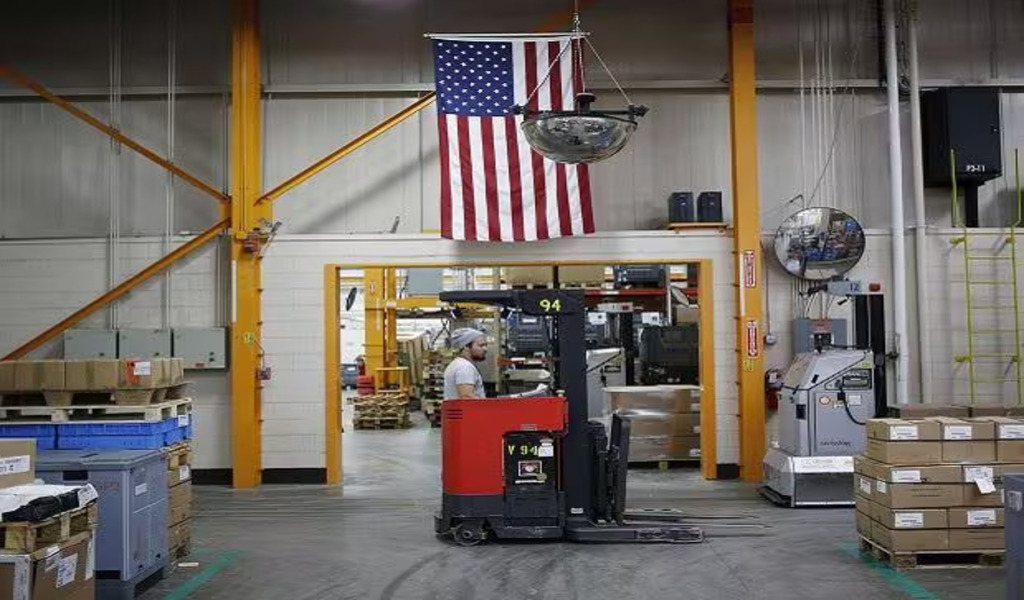Business
U.S. Economy Grew At A 2.9% Rate Last Quarter, Despite A Slowdown

(CTN NEWS) – Despite the pressure of rising interest rates and widespread concerns about an impending recession, the U.S. economy grew at a 2.9% annual rate from October through December, finishing 2022 with momentum.
According to the estimate released by the Commerce Department on Thursday, the country’s gross domestic product, which is the most comprehensive indicator of economic production.
Slowed down in the third quarter from the 3.2% annual growth rate it had registered from July through September.
Most economists predict the economy will continue to slow down in the upcoming quarter and enter at least a moderate recession by midyear.
Consumer spending remained strong last quarter, and firms replenished their supply chains. Spending by the federal government also increased GDP.

/ AP
However, due to rising mortgage rates, which are undermining the residential real estate market, investment in housing fell for a second consecutive quarter at a 27% annual pace.
After increasing by 5.9% in 2021, the GDP will increase by 2.1% overall in 2022.
The Federal Reserve’s aggressive rate rises is meant to result in the economy’s anticipated downturn in the coming months.
The Fed’s rate increases are intended to slow growth, restrain spending, and terminate the biggest inflationary wave in four decades.
The Fed increased its target rate seven times in the previous year. It is anticipated to do so once more the following week, albeit by a lower margin.
It has come as a great shock how resilient the American labor market has been.
According to federal data dating back to 1940, employers added 4.5 million employment last year, which was second only to the 6.7 million jobs added in 2021.
And the 3.5% unemployment rate in the previous month matched a 53-year low.

Regarding Thursday’s GDP report, President Joe Biden said, “The news couldn’t have been much better.” “We are taking the appropriate direction. We must now safeguard those advantages.:
However, it is unlikely that the good times for American workers will persist. Many individuals will cut down on their spending, and firms will probably hire fewer people as higher rates make borrowing and spending more expensive across the economy.
In a research paper, High-Frequency Economics’ principal U.S. economist Rubeela Farooqi stated that “recent statistics show that the pace of expansion could drop considerably in (the current quarter) as the impacts of restrictive monetary policy take root.”
A desired slowdown in the economy will be good news, according to the Fed.
About 70% of the economy is driven by consumer spending, which increased at a solid 2.1% annual rate from October through December, slightly less than the previous quarter’s 2.3% growth.

/ AP
More recent data, such as a 1.1% decline in retail sales last month, show that consumer spending has started to slow.
“That signals higher rates were starting to have a bigger toll and lays the ground for weaker growth in the first quarter of this year,” said Andrew Hunter, senior U.S. economist at Capital Economics.
Bank of America economists predict that growth will slow to a 1.5% annual pace in the quarter that runs from January through March and then decline for the remainder of the year.
Declining by 0.5% in the second quarter, 2% in the third, and 1.5% in the fourth.
The Fed has been acting in response to inflation that has been progressively declining but has remained persistently high.
Inflation over the previous year raged at 9.1% in June, the highest level in more than 40 years. It has now dropped to 6.5% in December but is still far higher than the Fed’s yearly target of 2%.

/ AP
Sal Guatieri, the senior economist at BMO Capital Economics, said: “The U.S. economy isn’t plummeting off a cliff, but it is losing vigour and risks contracting early this year.”
That should restrict future rate hikes by the Fed to two modest increases.
Politics also threaten the economy this year: if the Biden administration rejects House Republicans’ demands for significant spending cutbacks, they might refuse to increase the debt ceiling.
If the borrowing limit isn’t increased, the federal government won’t be able to cover all of its debts, which could ruin its reputation.
According to Moody’s Analytics, the ensuing instability might lead to the loss of close to 6 million American jobs in a devastating recession like the one brought on by the 2007–2009 financial crisis.
At least, the economy is probably starting the year on more stable ground than at the beginning of 2022.

/ GETTY IMAGE
From January through March of last year, the GDP declined by 1.6% annually and another 0.6% from April to June. Fears that a recession may have started arose from those two consecutive quarters of economic downturn.
According to data source FactSet, nearly half of the S&P 500 businesses mentioned a “recession” during corporate earnings calls for the April-June quarter of 2022.
This is the largest percentage since 2010. According to forecasters at Bank of America and Nomura, a recession was anticipated in the quarter between October and December.
But over the summer, the economy recovered its strength thanks to strong consumer spending and increasing exports.
RELATED CTN NEWS:

Business
PepsiCo Reduces Revenue Projections As North American Snacks And Key International Markets Underperform.

(VOR News) – In the third quarter of this year, Pepsi’s net income was $2.93 billion, which is equivalent to $2.13 per share. This was attributed to the company.
This is in stark contrast to net income of $3.09 billion, which is equivalent to $2.24 per share, during the same period in the previous year. The company’s earnings per share were $2.31 when expenses were excluded.
Net sales decreased by 0.6%, totaling $23.32 billion. Organic sales increased by 1.3% during the quarter when the effects of acquisitions, divestitures, and currency changes are excluded.
Pepsi’s beverage sales fell this quarter.
The most recent report indicates that the beverage and food sectors of the organization experienced a 2% decline in volume. Consumers of all income levels are demonstrating a change in their purchasing habits, as indicated by CEOs’ statements from the previous quarter.
Pepsi’s entire volume was adversely affected by the lackluster demand they encountered in North America. An increasing number of Americans are becoming more frugal, reducing the number of snacks they ingest, and reducing the number of times they purchase at convenience stores.
Furthermore, Laguarta observed that the increase in sales was partially attributed to the election that occurred in Mexico during the month of June.
The most significant decrease in volume was experienced by Quaker Foods North America, which was 13%. In December, the company announced its initial recall in response to a potential salmonella infection.
Due to the probability of an illness, the recall was extended in January. Pepsi officially closed a plant that was implicated in the recalls in June, despite the fact that manufacturing had already been halted.
Jamie Caulfield, the Chief Financial Officer of Pepsi and Laguarta, has indicated that the recalls are beginning to have a lessening effect.
Frito-Lay experienced a 1.5% decline in volume in North America. The company has been striving to improve the value it offers to consumers and the accessibility of its snack line, which includes SunChips, Cheetos, and Stacy’s pita chips, in the retail establishments where it is sold.
Despite the fact that the category as a whole has slowed down in comparison to the results of previous years, the level of activity within the division is progressively increasing.
Pepsi executives issued a statement in which they stated that “Salty and savory snacks have underperformed year-to-date after outperforming packaged food categories in previous years.”
Pepsi will spend more on Doritos and Tostitos in the fall and winter before football season.
The company is currently promoting incentive packets for Tostitos and Ruffles, which contain twenty percent more chips than the standard package.
Pepsi is expanding its product line in order to more effectively target individuals who are health-conscious. The business announced its intention to acquire Siete Foods for a total of $1.2 billion approximately one week ago. The restaurant serves Mexican-American cuisine, which is typically modified to meet the dietary needs of a diverse clientele.
The beverage segment of Pepsi in North America experienced a three percent decrease in volume. Despite the fact that the demand for energy drinks, such as Pepsi’s Rockstar, has decreased as a result of consumers visiting convenience stores, the sales of well-known brands such as Gatorade and Pepsi have seen an increase throughout the quarter.
Laguarta expressed his opinion to the analysts during the company’s conference call, asserting, “I am of the opinion that it is a component of the economic cycle that we are currently experiencing, and that it will reverse itself in the future, once consumers feel better.”
Additionally, it has been noted that the food and beverage markets of South Asia, the Middle East, Latin America, and Africa have experienced a decline in sales volume. The company cut its forecast for organic revenue for the entire year on Tuesday due to the business’s second consecutive quarter of lower-than-anticipated sales.
The company’s performance during the quarter was adversely affected by the Quaker Foods North America recalls, the decrease in demand in the United States, and the interruptions that occurred in specific international markets, as per the statements made by Chief Executive Officer Ramon Laguarta.
Pepsi has revised its forecast for organic sales in 2024, shifting from a 4% growth rate to a low single-digit growth rate. The company reiterated its expectation that the core constant currency profitability per share will increase by a minimum of 8% in comparison to the previous year.
The company’s shares declined by less than one percent during premarket trading. The following discrepancies between the company’s report and the projections of Wall Street were identified by LSEG in a survey of analysts:
SOURCE: CNBC
SEE ALSO:
Old National Bank And Infosys Broaden Their Strategic Partnership.
Business
Old National Bank And Infosys Broaden Their Strategic Partnership.

(VOR News) – Old National Bank, a commercial bank with its headquarters in the Midwest, and Infosys, a firm that specializes in information technology, have recently entered into a strategic expansion of their link, which has been in place for the past four years.
This expansion is more likely to take place sooner rather than later, with the likelihood being higher.
For the purpose of making it possible for Old National Bank to make use of the services, solutions, and platforms that are offered by Infosys, the objective of this expansion is to make it possible for the bank to transform its operations and processes through the application of automation and GenAI, as well as to change significant business areas.
This lets the bank leverage Infosys’ services, solutions, and platforms.
Old National Bank Chairman and CEO Jim Ryan said, “At Old National, we are committed to creating exceptional experiences for both our customers and our fellow employees.”
This statement is applicable to Old National Bank. Infosys is carefully managing the business process innovations that it is putting us through, putting a strong emphasis on efficiency and value growth throughout the process to ensure that it is carried out efficiently.
This is a routine occurrence throughout the entire operation. Because of Infosys’ dedication to our development and success, we are incredibly appreciative of the assistance they have provided.
Old National has been receiving assistance from Infosys in the process of updating its digital environment since the year 2020, according to the aforementioned company.
Ever since that time, the company has been providing assistance. The provision of this assistance has been accomplished through the utilization of a model that is not only powerful but also capable of functioning on its own power.
Infosys currently ranks Old National thirty-first out of the top thirty US banks.
This ranking is based on the fact that Old National is the nation’s largest banking corporation.
It is estimated that the total value of the company’s assets is approximately fifty-three billion dollars, while the assets that are currently being managed by the organization are valued at thirty billion dollars.
Dennis Gada, the Executive Vice President and Global Head of Banking and Financial Services, stated that “Old National Bank and Infosys possess a robust cultural and strategic alignment in the development, management, and enhancement of enterprise-scale solutions to transform the bank’s operations and facilitate growth.”
This remark referenced the exceptional cultural and strategic synergy between the two organizations. Dennis Gada is the one who asserted this claim. This was articulated explicitly concerning the exceptional cultural congruence and strategy alignment of the two organizations.
We are pleased to announce that the implementation of Infosys Topaz will substantially expedite the transformation of Old National Bank’s business processes and customer service protocols. We are exceedingly enthusiastic about this matter. We are quite thrilled about this specific component of the scenario.
Medium-sized banks operating regionally will continue to benefit from our substantial expertise in the sector, technology, and operations. This specific market segment of Infosys will persist in benefiting from our extensive experience. This phenomenon will enable this market sector to sustain substantial growth and efficiency benefits.
SOURCE: THBL
SEE ALSO:
American Water, The Largest Water Utility In US, Is Targeted By A Cyberattack
States Sue TikTok, Claiming Its Platform Is Addictive And Harms The Mental Health Of Children
Qantas Airways Apologizes After R-Rated Film Reportedly Airs On Every Screen During Flight
Business
American Water, The Largest Water Utility In US, Is Targeted By A Cyberattack

The largest regulated water and wastewater utility company in the United States stated Monday that it had been the target of a cyberattack, forcing the company to halt invoicing to consumers.
American Water, The Largest Water Utility In US, Is Targeted By A Cyberattack
American Water, based in New Jersey and serving over 14 million people in 14 states and 18 military facilities, said it learned of the unauthorized activity on Thursday and quickly took precautions, including shutting down certain systems. The business does not believe the attack had an impact on its facilities or operations and said employees were working “around the clock” to determine the origin and scale of the attack.

According to their website, American Water operates over 500 water and wastewater systems in around 1,700 communities across California, Georgia, Hawaii, Illinois, Indiana, Iowa, Kentucky, Maryland, Missouri, New Jersey, Pennsylvania, Tennessee, Virginia, and West Virginia.
SOURCE | AP
-

 News4 years ago
News4 years agoLet’s Know About Ultra High Net Worth Individual
-
Entertainment2 years ago
Mabelle Prior: The Voice of Hope, Resilience, and Diversity Inspiring Generations
-
News11 years ago
Enviromental Groups Tell Mekong Leaders Lao Dam Evaluation Process Flawed
-

 Health4 years ago
Health4 years agoHow Much Ivermectin Should You Take?
-

 Tech2 years ago
Tech2 years agoTop Forex Brokers of 2023: Reviews and Analysis for Successful Trading
-

 Lifestyles3 years ago
Lifestyles3 years agoAries Soulmate Signs
-

 Entertainment3 years ago
Entertainment3 years agoWhat Should I Do If Disney Plus Keeps Logging Me Out of TV?
-

 Health3 years ago
Health3 years agoCan I Buy Ivermectin Without A Prescription in the USA?